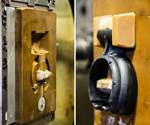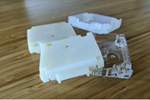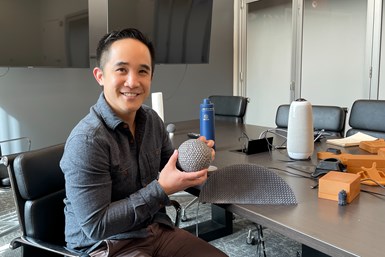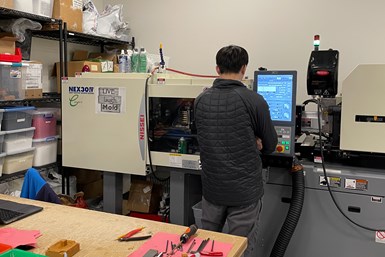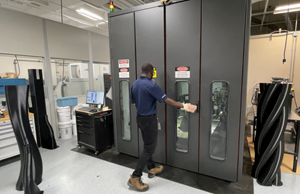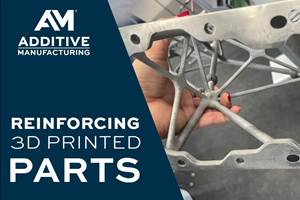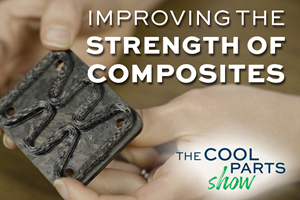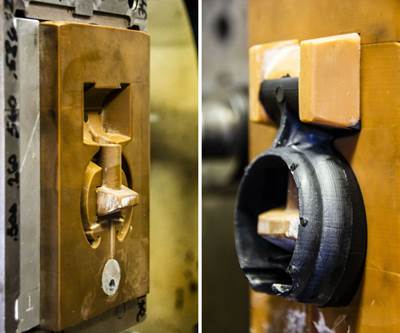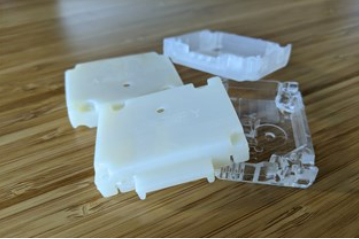5G, the telecommunications advance that promises to carry more information at greater speeds, has an energy problem. 5G technology uses millimeter-wave transmission, a method that can precisely deliver data to specific phones or devices, but one that doesn’t inherently let that data penetrate through common objects like trees, walls or even the human body.
Radio frequency (RF) devices provide a solution, by sitting in front of the radiating elements or antennae to bend, focus and steer the RF energy toward its intended destination. RF lenses will be key to the proliferation of 5G communications, and producing capable devices quickly will be critical.
Karlo Delos Reyes, cofounder of Fortify, holds a 3D printed Luneberg lens representing the next major niche for the company. Its foray into RF devices builds on lessons learned in another niche: injection molding (orange 3D printed mold tooling is visible on the table in this photo).
Conventional RF antenna lenses are made by fabricating layers of material of varying densities through layup. The method works, but can result in RF devices that are heavier, more complex and labor intensive to produce. Fortify, a maker of additive manufacturing technology for specialized applications, has established solutions for 3D printing complex RF geometries directly using high-performance resins created in collaboration with Rogers Corporation that are suited to the company’s Flux series of photopolymerization or digital light processing (DLP) 3D printers.
“We are able to control the waves through filler materials in the resin and the design of the lattice. Changing the density and gradient of the lattice can augment the beam pattern in various ways,” says Karlo Delos Reyes, cofounder of the company. 3D printed RF lenses are simpler to produce, can be more compact, and even offer performance improvements over conventional solutions. “These are low-loss devices, which makes the antennas more efficient,” Delos Reyes says.
3 Keys to 3D Printing RF Devices
The RF devices I recently saw at Fortify’s Boston-area headquarters feature gyroid-based lattices that vary in unit size and density. Smaller unit cells achieve higher frequencies, and large ones suit lower frequencies. Those lattices, combined with tuning of the filler materials in the 3D printing process, can change the dielectric constant of the material and control radio waves through a compact device.

A sampling of the types of RF devices that Fortify is able to design and produce with its 3D printing technology.
There are several keys to making this 3D printed RF solution work. They include:
While Fortify’s aim is for customers to adopt its Fluxprint platform in-house, machines at the company’s headquarters routinely make parts for potential and existing clients. “To sell solutions, you need to sell parts first,” Delos Reyes says.
- The Radix material, a highly viscous resin developed in collaboration with Rogers Corporation. Like most materials used in Fortify Flux 3D printers, it consists of a base resin with filler materials to impart desired properties.
- Fortify’s DLP platform with Continuous Kinetic Mixing (CKM), which makes it possible not only to print with viscous materials like the Radix resin, but to keep the additives inside properly dispersed throughout the entire printing process. “We can print with resins that are two to ten times more viscous than typical DLP resins,” Delos Reyes says.
- Design software that is still in work (a beta launch is planned for later in 2023) to help customers translate RF simulations from current industry-standard software into 3D printable designs with minimal friction.
An example of a 13" lens produced on the Fortify Flux platform using Radix, capable of functioning between 3 and 18 GHz. Photo Credit: Fortify
“An RF engineer doesn’t think in mechanical terms,” Delos Reyes says. “We want to make it as easy as possible for them to translate their work, and remove barriers to adoption.”
The solution is being used by a number of partners including Lockheed Martin (which is also an investor in Fortify) and private commercial telecom providers.
Empathy in Applications
Fortify’s entry into the radio frequency device space builds on past lessons learned in another niche: injection mold tooling. The company jointly developed a ceramic-reinforced polymer with Henkel that is suitable for rapid production of prototype and short-run injection molds. Customers using this solution for mold tooling are served by Fortify’s own team of injection molding specialists, employees who understand the pain points and concerns of these users.
Most 3D printing technology companies don’t have an in-house injection molding press, but Fortify sees this as a necessity for serving customers interested in using its technology for 3D printed molds (top).
“I hire most for empathy,” Delos Reyes says, citing the team of business development professionals, sales representatives and applications engineers that he leads. The approach is paying off in injection molding, illustrating how 3D printing can enter and advance an established industry.
Radio frequency is the next such area of focus for the company. Similar to its approach to mold tooling, Fortify has invested in R&D, industry-specific RF testing equipment, and personnel who can build bridges to current and potential customers interested in this solution.
This applications-first approach means that Fortify doesn’t see itself so much as an AM company, Delos Reyes says, but as a solutions provider diving deep into the niches it can serve.
“We try to avoid ‘shiny object syndrome’ and constantly going after the next cool thing,” Delos Reyes says. “For us, applications are the key to success in additive manufacturing.”
Related Content
Eaton Developing Carbon-Reinforced PEKK to Replace Aluminum in Aircraft Air Ducts
3D printable material will meet ESD, flammability and other requirements to allow for flexible manufacturing of ducts, without tooling needed today.
Read MoreVideo: Reinforcing (and Joining) Parts After 3D Printing
Reinforce 3D has developed a method that can be applied to strengthen 3D printed parts by feeding continuous fiber and resin through them. The technique also enables joining parts of various materials and manufacturing methods.
Read MoreLouisville Slugger Uses Formlabs Technology to Accelerate Innovation
Louisville Slugger relies on Formlabs’ Form 3 stereolithography 3D printer to create both prototypes and manufacturing aids for designs of the composite and aluminum bats swung by youth and collegiate players.
Read More3D Printed Preforms Improve Strength of Composite Brackets: The Cool Parts Show Bonus
On this episode, we look at a pin bracket for the overhead bin of an airplane made in two composite versions: one with continuous fiber 3D printed reinforcements plus chopped fiber material, and one molded from chopped fiber alone.
Read MoreRead Next
New Opportunities for Quantum Physics: The Cool Parts Show #11
What does 3D printing have to do with quantum physics? We'll look at how the technology is enabling quantum physics research in this episode of The Cool Parts Show.
Read MoreMagnetic 3D Printing with Fiber Reinforcement Fills Tooling Gap
Fortify’s Digital Composite Manufacturing (DCM) platform pairs high-performance resins with fiber reinforcement that can be controlled at the voxel level. The process promises a faster route to durable injection mold tooling.
Read More3D Printed Mold Tooling Advances in Performance With Proprietary Resin
Material improvements offer turnkey production and cost trimming with 3D printed mold tooling. A new, proprietary resin addresses the current limitations associated with 3D printing in polymer.
Read More

.jpg;width=70;height=70;mode=crop)

